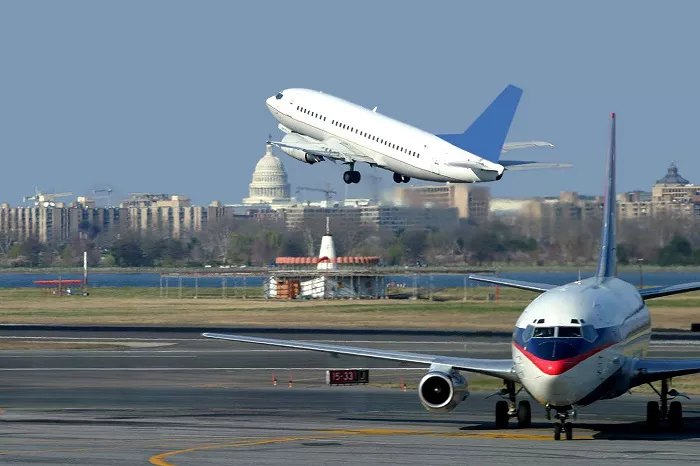The United States boasts some of the largest and busiest airports in the world. These airports serve as major hubs for domestic and international travel, connecting millions of passengers each year. In this article, we will explore the top 10 largest airports in the U.S., highlighting their size, passenger traffic, and unique features.
Top 10 Largest Airports in the United States
1. Denver International Airport (DIA)
Denver International Airport, commonly known as DIA, is the largest airport in the United States by land area. Located approximately 25 miles east of downtown Denver, Colorado, it covers over 33,500 acres, making it not only the largest in the U.S. but also the second-largest globally. Opened in 1995, DIA has six runways and a single terminal with three concourses. In 2023, it handled approximately 77.8 million passengers, making it the third-busiest airport in the country.
Key Features:
Runways: Six, with one of the longest in the U.S. at 16,000 feet.
AirAdvisor
Terminal: A single terminal with three concourses, offering a wide range of amenities.
Art and Architecture: Known for its distinctive peaked roof design and extensive public art collection.
2. Dallas/Fort Worth International Airport (DFW)
Situated between the cities of Dallas and Fort Worth in Texas, DFW covers approximately 27 square miles. It features five terminals and seven runways. In 2023, DFW served around 81.8 million passengers, ranking it as the second-busiest airport in the U.S.
Key Features:
Terminals: Five, each offering a variety of dining and shopping options.
Runways: Seven, accommodating a high volume of air traffic.
Transportation: Extensive parking facilities and a dedicated Skylink train system connecting terminals.
3. Hartsfield-Jackson Atlanta International Airport (ATL)
Located in Atlanta, Georgia, ATL is one of the busiest airports globally. It has two terminals and five runways. In 2023, ATL handled over 104.6 million passengers, making it the busiest airport in the U.S.
Key Features:
Terminals: Two, with Terminal South serving domestic flights and Terminal North serving international flights.
Runways: Five, facilitating efficient flight operations.
Connectivity: Extensive domestic and international flight network, serving as a hub for Delta Air Lines.
4. O’Hare International Airport (ORD)
Located in Chicago, Illinois, O’Hare is a major hub for both domestic and international flights. It features four terminals and eight runways. In 2023, O’Hare served approximately 73.9 million passengers, making it the fifth-busiest airport in the U.S.
Key Features:
Terminals: Four, each providing a range of services and amenities.
Runways: Eight, supporting a high frequency of flights.
Transportation: Well-connected to downtown Chicago via the Blue Line of the Chicago ‘L’ train system.
5. Los Angeles International Airport (LAX)
LAX is located in Los Angeles, California, and is a primary gateway to Asia and Europe. It has nine terminals and four runways. In 2023, LAX accommodated around 75 million passengers, making it the fourth-busiest airport in the U.S.
Key Features:
Terminals: Nine, each offering unique dining and shopping experiences.
Runways: Four, designed to handle a large number of flights daily.
Iconic Design: Features the distinctive Theme Building, a symbol of mid-century modern architecture.
6. Denver International Airport (DIA)
As previously mentioned, Denver International Airport is the largest airport in the U.S. by land area. Located approximately 25 miles east of downtown Denver, Colorado, it covers over 33,500 acres, making it not only the largest in the U.S. but also the second-largest globally. Opened in 1995, DIA has six runways and a single terminal with three concourses. In 2023, it handled approximately 77.8 million passengers, making it the third-busiest airport in the country.
Key Features:
Runways: Six, with one of the longest in the U.S. at 16,000 feet.
AirAdvisor
Terminal: A single terminal with three concourses, offering a wide range of amenities.
Art and Architecture: Known for its distinctive peaked roof design and extensive public art collection.
7. Orlando International Airport (MCO)
Located in Orlando, Florida, MCO serves as a major gateway to Central Florida’s attractions. It has two terminals and four runways. In 2023, MCO served approximately 57.7 million passengers, making it the seventh-busiest airport in the U.S.
Key Features:
Terminals: Two, designed to handle both domestic and international flights.
Runways: Four, accommodating a high volume of air traffic.
8. John F. Kennedy International Airport (JFK)
Located in Queens, New York City, JFK is one of the busiest airports in the U.S. It has six terminals and four runways. In 2023, JFK served approximately 59 million passengers, making it the sixth-busiest airport in the country.
Key Features:
Terminals: Six, each offering a variety of international and domestic flight options.
Runways: Four, designed to handle a high volume of air traffic.
International Gateway: Serves as a primary entry point to the U.S., with numerous international airlines operating from its terminals.
9. Las Vegas Harry Reid International Airport (LAS)
Located in Paradise, Nevada, near Las Vegas, LAS is a major airport serving both domestic and international travelers. It has two terminals and four runways. In 2023, LAS accommodated around 49 million passengers, making it the ninth-busiest airport in the U.S.
Key Features:
Terminals: Two, offering a range of services and amenities for travelers.
Runways: Four, supporting a significant number of flights daily.
Entertainment Hub: Provides a variety of entertainment options, reflecting the vibrant culture of Las Vegas.
10. Seattle-Tacoma International Airport (SEA)
Situated between Seattle and Tacoma in Washington State, SEA is a key airport in the Pacific Northwest. It has one terminal and three runways. In 2023, SEA served approximately 51 million passengers, making it the tenth-busiest airport in the U.S.
Key Features:
Terminal: A single terminal with two concourses, streamlining passenger flow.
Runways: Three, accommodating various aircraft types and sizes.
Sustainability Initiatives: Known for its efforts in environmental sustainability and green building practices.
These airports play crucial roles in connecting the U.S. to the rest of the world, each offering unique features and services to accommodate the millions of passengers who travel through them annually.

